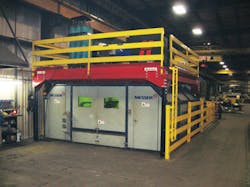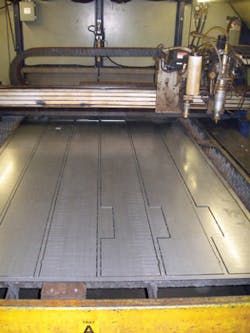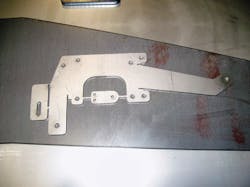Dual-process cutting provides new level of performance and productivity
Fiber laser and plasma solution is complementary
Ken Woods
It should come as no surprise to anyone who made it through a winter filled with bitter-cold temperatures and unusual amounts of snow and ice that business at Monroe Truck Equipment (MTE; Monroe, MI) is booming. They manufacture equipment for snow and ice handling along with truck body equipment, and have seen orders far exceed their expectations. MTE started as a one-man blacksmith shop in 1958. Today, it has evolved into a 550-person, around-the-clock operation with facilities in several states. In total, employees process more than 18,000 trucks per year, offering a worldwide ship-thru program in which they deliver trucks directly for Detroit's Big-3.
Since their products span a broad range of capabilities, so does their material and the need to cut it all efficiently. A few years ago, they decided they needed to upgrade their laser equipment that was over a decade old. MTE turned to several new systems: a punch plasma to handle up to 1/2 in. mild steel, a long bed plasma table to process 10-gauge to 1 in. material, and a 4kW CO2 laser with a tower material handling system. In addition, they added a fourth piece of equipment—a dual-process cutting system that combined a laser and plasma on a single table to improve flexibility and productivity (Figure 1).
The table from Messer Cutting Systems was unique in that it was one of the first to combine plasma with a fiber laser, rather than CO2, on the same table. Because of the ease of the fiber beam delivery, it was quite straightforward to integrate the equipment and MTE took delivery of the first system more than two years ago. There were other unique features for this system beyond the integration of the two complimentary processes.
Since the table was originally built for a trade show, MTE included an overhead deck for the power supplies and chillers to save footprint space on the show floor. When MTE took delivery of the system, they decided to also save the footprint space on their production floor and help protect the equipment from forklift traffic and steel handling.
"With our broad range of equipment capability, we have a lot of flexibility in how we process our material," says Chris Barber, shop superintendent for the company's Snow and Ice Division. "The fiber laser allows us to process smaller internal features efficiently and then realize the productivity and speed advantage of plasma around the larger perimeter. Another nice feature of the combination is that the hourly operating costs are very similar for the two processes, but the range and productivity are better than each process could have realized alone."
Many people think of fiber laser and plasma as being competitive cutting technologies, but in truth, the two processes are complimentary. Fiber laser and plasma are both capable of working side by side to help companies expand their capabilities, or bring outsourced work back in-house. Since the two are complimentary and can use the same cutting table and a common controller (CNC), the capital costs are much more reasonable. The best solution for an end user is one where the required range and volume of parts is met by a machine operating at near-full capacity, regardless of the integrated cutting technologies.
The integration of two separate cutting tools on a single system does have some unique challenges. Since there is a mechanical offset between the two tools, careful attention must be paid to making sure the offsets are adjusted properly in the CNC. Occasional inspection of the parts is required, but for most of the parts required by MTE, this is not a major issue. "Over 97 percent of our parts have tolerance requirements which are easily met with all of our equipment," Barber explains.
These dual-process positional tolerances are also well within measurement achieved by Hypertherm (Hanover, NH) during its own internal testing on a dual process plasma/fiber laser table. It is well known that lasers can hold tighter tolerances than plasma, but modern high-definition plasma systems are capable of meeting dimensional and positional tolerances in the .030 in. range.
These tolerances are well within testing results achieved by Hypertherm during its testing. Holding 1/16 in. dimensional tolerance with a modern high-definition plasma system is usually achieved quite easily.
It is worth noting the difference between dimensional tolerance for features of size (hole diameter, slot width, side to side measurements) and positional tolerance (location of a feature relative to other features of size). Dimensional tolerance is what is usually thought of when tolerances are quoted, and are the measurements that would be done with standard measuring equipment such as calipers or micrometers over a broad sample of parts. Positional tolerance is the bullseye zone for the relative location of features within a single part, such as a hole location relative to two locating edges. Dimensional tolerance can be used to make sure a bolt will fit through a single hole without too much play, while positional tolerance can make sure a bolt will always fit through two parts when they are used in an assembly. Because the tool changes between the internal laser features and the external plasma features, it is the positional tolerance of the hole locations that can vary a bit over the course of a shift due to a collision, laser beam re-centering, or minor consumable wear.
Each piece of equipment at MTE serves a specific need, helping it cut parts for equipment that ranges from snow plows to sanding equipment, dump-truck bodies, towing bodies, hitches, and spreaders. The long-bed plasma table can process plates up to 20 ft long and covers a broad range of material thicknesses. "This is not a thick-plate-only, 400A plasma," adds Barber. "We do long, 10-gauge parts for some of our components that we cannot fit on the laser systems." (Figure 2)
The punch plasma can pop out holes at an alarming rate and then cut the profile with high-definition accuracy. Some custom modifications have extended the length capacity with repositioning of the plate. The laser with a tower runs largely unattended, cutting many of the mid-thickness range materials.
"We can load it up on Saturday and start the week 60 to 70 sheets ahead on Monday—it's been a real productivity booster," says Barber. The combination 2.2kW fiber laser and HPR400XD high-definition plasma system handles much of the other mild and stainless steels up to 1/4 in., and can be run in laser-only or plasma-only mode to help balance capacity on all the other systems. (Figure 3) "We really appreciate some of the unique capabilities achieved by the dual-process system," says Barber.
There's no doubt the dual-process system is paying dividends for MTE, providing the company with more flexibility that it ever had operating single-process systems. Dual-process cutting opens up more options for smaller companies as well, many of whom are already adopting and using the systems. Instead of buying and finding space for two separate cutting tables, companies only need to spend money on a single table, immediately lowering their capital equipment cost. In addition, the added flexibility of the dual-process system allows smaller companies to bring in jobs they may have outsourced in the past, allowing them to further maximize their profits and get current jobs out the door faster. MTE can certainly attest to that. Given the amount of business the company received as a result of this past winter, the backlog of orders will keep all systems running for quite a while, and "that's not a bad problem to have," concludes Barber.
KEN WOODS([email protected]) is principal engineer for Hypertherm Laser Systems, Hanover, NH.



